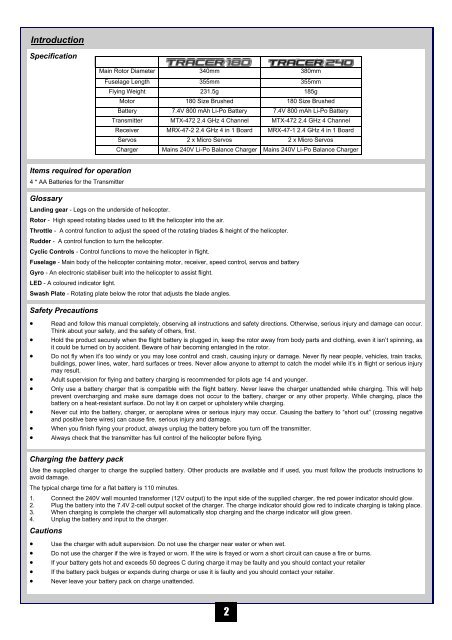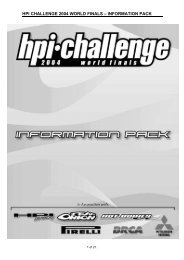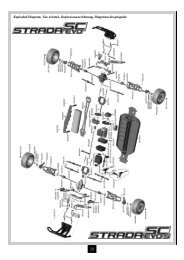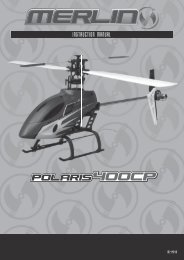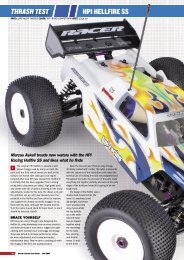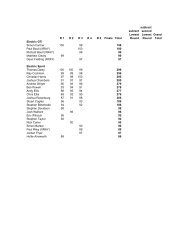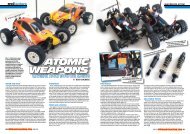INSTRUCTION MANUAL - HPI Racing UK
INSTRUCTION MANUAL - HPI Racing UK
INSTRUCTION MANUAL - HPI Racing UK
Create successful ePaper yourself
Turn your PDF publications into a flip-book with our unique Google optimized e-Paper software.
Introduction<br />
Specification<br />
Tracer 180 Tracer 240<br />
Main Rotor Diameter 340mm 380mm<br />
Fuselage Length 355mm 355mm<br />
Flying Weight 231.5g 185g<br />
Motor 180 Size Brushed 180 Size Brushed<br />
Battery 7.4V 800 mAh Li-Po Battery 7.4V 800 mAh Li-Po Battery<br />
Transmitter MTX-472 2.4 GHz 4 Channel MTX-472 2.4 GHz 4 Channel<br />
Receiver MRX-47-2 2.4 GHz 4 in 1 Board MRX-47-1 2.4 GHz 4 in 1 Board<br />
Servos 2 x Micro Servos 2 x Micro Servos<br />
Charger Mains 240V Li-Po Balance Charger Mains 240V Li-Po Balance Charger<br />
Items required for operation<br />
4 * AA Batteries for the Transmitter<br />
Glossary<br />
Landing gear - Legs on the underside of helicopter.<br />
Rotor - High speed rotating blades used to lift the helicopter into the air.<br />
Throttle - A control function to adjust the speed of the rotating blades & height of the helicopter.<br />
Rudder - A control function to turn the helicopter.<br />
Cyclic Controls - Control functions to move the helicopter in flight.<br />
Fuselage - Main body of the helicopter containing motor, receiver, speed control, servos and battery<br />
Gyro - An electronic stabiliser built into the helicopter to assist flight.<br />
LED - A coloured indicator light.<br />
Swash Plate - Rotating plate below the rotor that adjusts the blade angles.<br />
Safety Precautions<br />
• Read and follow this manual completely, observing all instructions and safety directions. Otherwise, serious injury and damage can occur.<br />
Think about your safety, and the safety of others, first.<br />
• Hold the product securely when the flight battery is plugged in, keep the rotor away from body parts and clothing, even it isn’t spinning, as<br />
it could be turned on by accident. Beware of hair becoming entangled in the rotor.<br />
• Do not fly when it’s too windy or you may lose control and crash, causing injury or damage. Never fly near people, vehicles, train tracks,<br />
buildings, power lines, water, hard surfaces or trees. Never allow anyone to attempt to catch the model while it’s in flight or serious injury<br />
may result.<br />
• Adult supervision for flying and battery charging is recommended for pilots age 14 and younger.<br />
• Only use a battery charger that is compatible with the flight battery. Never leave the charger unattended while charging. This will help<br />
prevent overcharging and make sure damage does not occur to the battery, charger or any other property. While charging, place the<br />
battery on a heat-resistant surface. Do not lay it on carpet or upholstery while charging.<br />
• Never cut into the battery, charger, or aeroplane wires or serious injury may occur. Causing the battery to “short out” (crossing negative<br />
and positive bare wires) can cause fire, serious injury and damage.<br />
• When you finish flying your product, always unplug the battery before you turn off the transmitter.<br />
• Always check that the transmitter has full control of the helicopter before flying.<br />
Charging the battery pack<br />
Use the supplied charger to charge the supplied battery. Other products are available and if used, you must follow the products instructions to<br />
avoid damage.<br />
The typical charge time for a flat battery is 110 minutes.<br />
1. Connect the 240V wall mounted transformer (12V output) to the input side of the supplied charger, the red power indicator should glow.<br />
2. Plug the battery into the 7.4V 2-cell output socket of the charger. The charge indicator should glow red to indicate charging is taking place.<br />
3. When charging is complete the charger will automatically stop charging and the charge indicator will glow green.<br />
4. Unplug the battery and input to the charger.<br />
Cautions<br />
• Use the charger with adult supervision. Do not use the charger near water or when wet.<br />
• Do not use the charger if the wire is frayed or worn. If the wire is frayed or worn a short circuit can cause a fire or burns.<br />
• If your battery gets hot and exceeds 50 degrees C during charge it may be faulty and you should contact your retailer<br />
• If the battery pack bulges or expands during charge or use it is faulty and you should contact your retailer.<br />
• Never leave your battery pack on charge unattended.<br />
2


